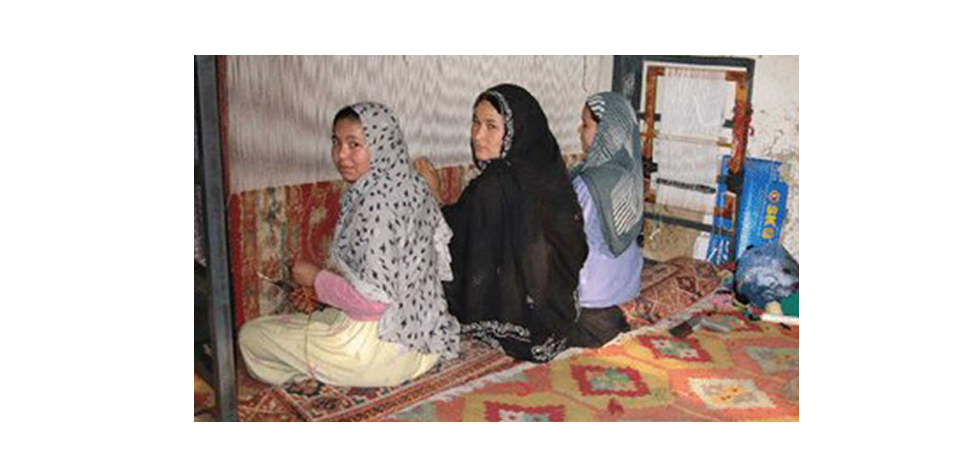Aryana is the ancient name for Afghanistan and parts of Persia, Beluchistan and central Asia. This is a region with an old weaving tradition. The name has now been given to rugs woven by a collection of nomadic Turkoman refugees from Central Asia and Afghanistan, descendants of Mogul and Turkic tribes. These people left Uzbekistan and Turmenistan in 1920 to avoid sovietization and settlement and settled near Andkhuy and Daulatabad in northern Afghanistan. In the early 1980's they walked across the mountains of Afghanistan to seek political refuge in the tribally administered Northwest Frontier Province of Pakistan. Weaving takes place in small workshops and homes in Turkoman communities.
In no case is factory labor involved, nor abusive child labor practices. However, since weaving takes place at home, children quite naturally learn their parents trade. In many cases, the children are attending school, and your rug purchase at Little River helps to fund those schools and literacy programs. The Project for Cultural Survival, a non-profit Turkoman weaving collective, funds the Ersari Academy in Attock. Here Muslim girls, as well as boys, are learning how to read for the first time in tribal history. We have more information about the Project in our store.
Wool used in these rugs comes from Karakul sheep raised in the mountains of Afghanistan. This wool is long staple (each hair is 6" - 10" long) and is exceptionally dense, strong, lustrous and soft. In Quetta, Beluchistan, it is gently washed with pure soap and water, carefully hand-combed and hand-spun on drop spindles. This results in a less processed yarn and produces a longer wearing and more beautiful rug.
After the wool is spun into yarn, it is sent to Lahore where it is colored with native vegetal dyes grown in Pakistan and India. Natural dyes are non-toxic and are a renewable resource. Synthetic chemical dyes are never used in these productions. Dye stuffs include indigo, madder root, ousparak, kesuphul, mulberry, walnut husk and pomegranate. Dyeing takes is done one small lot at a time. Hanks of yarn are suspended from sticks and immersed in tubs that are about three feet in diameter. Abrash, or color variation, is characteristic of rugs woven with vegetal dyes and handspun wool. The wool will absorb different amounts of dye in the thick and thin sections of spun wool, creating the desirable varigated effect that is often imitated but cannot be as beautiful when mechanically replicated. Each lot of dyed wool is sun-dried on the roof of the godam {workshop}.
From the godam in Lahore, the wool is sent north to refugee settlements and weaving centers that border Afghanistan. The "putting out" system is used where weavers are provided with wool, design and looms. They generally weave from a "cartoon" which specifies knot placement and color combinations. Weavers are related by blood, marriage or tribal clan, and are usually multiple generations of Turkmen women (grandmothers, mothers, and their daughters) who weave alongside one another. All weaving, with the exception of very large pieces, takes place in individual family homes. Now many young men also are involved in weaving, something that was not common in Afghanistan, but evolved with the refugee situation in Pakistan. They primarily weave the carpets larger than 10 x 14, too large for a loom to fit in a family home. They usually range in age from 16 to 30 and work together in groups of 4 to 8, working side-by-side on the production of a large rug. The knotting is Persian, or asymmetrical. Warps and wefts are made either of cotton or of wool. Cotton rugs have a stiffer feel to them, while a wool foundation results in a floppier, softer feel. Each wears equally well. The choice is an aesthetic one. After months, even up to a year, of weaving, hours of work still remain after the carpet is woven.
The rugs are returned to the godam in Lahore where each rug is washed several times with mild soap and water. The rug is sun-dried on the roof of the workshop and hand sheared to a smooth, even surface. Fringes (the warp ends) are tied, knotted and cut to an even length. Loose ends of wool are removed from the back of the rug. The rug is then brushed, shaken, beaten and vacuumed. Aryana are still made in the same way - and have the same look and feel - as rugs that came from the Sultanabad and Mahal area of Persia in the 19th Century. Altogether it is a journey of thousands of kilometers with a tremendous amount of attention and hand labor, however the result is a carpet that radiates beauty and tradition, combining the centuries old skills with the highest quality of all traditional materials. A glowing patina will develop after years of use. Aryana's will always be a limited production. These timeless rugs will enhance any room and represent excellent investment potential. We are pleased to be one of a handful of shops offering Aryana rugs and recommend them without qualification.
The Turkomen weavers also produce our Antique Aryana's, with a shorter pile to replicate the well-worn nap of a much-loved antique rug that has been tread on for years, our Faryab's and Bamiyan's, which are more finely knotted at approximately 150-160 knots per square inch, and our Nooristan's. Nooristan is the finest quality that we offer, at 275 knots per square inch. The typical Nooristan rug contains at least 13 different vegetable dye colors. The very finely handspun wool used and the extraordinary weave with a depressed warp, yet a supple hand, give these carpets a subtle and different character which must be seen up close to be appreciated.
These are truly exceptional handmades.
















